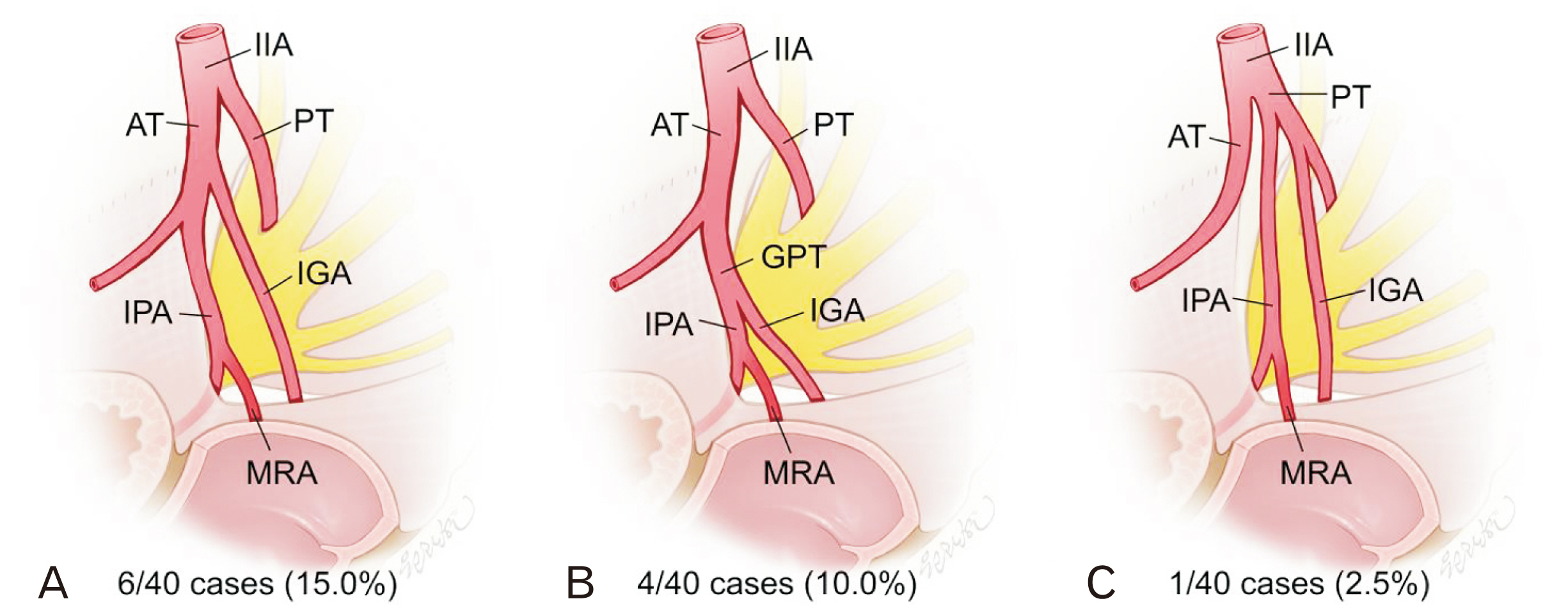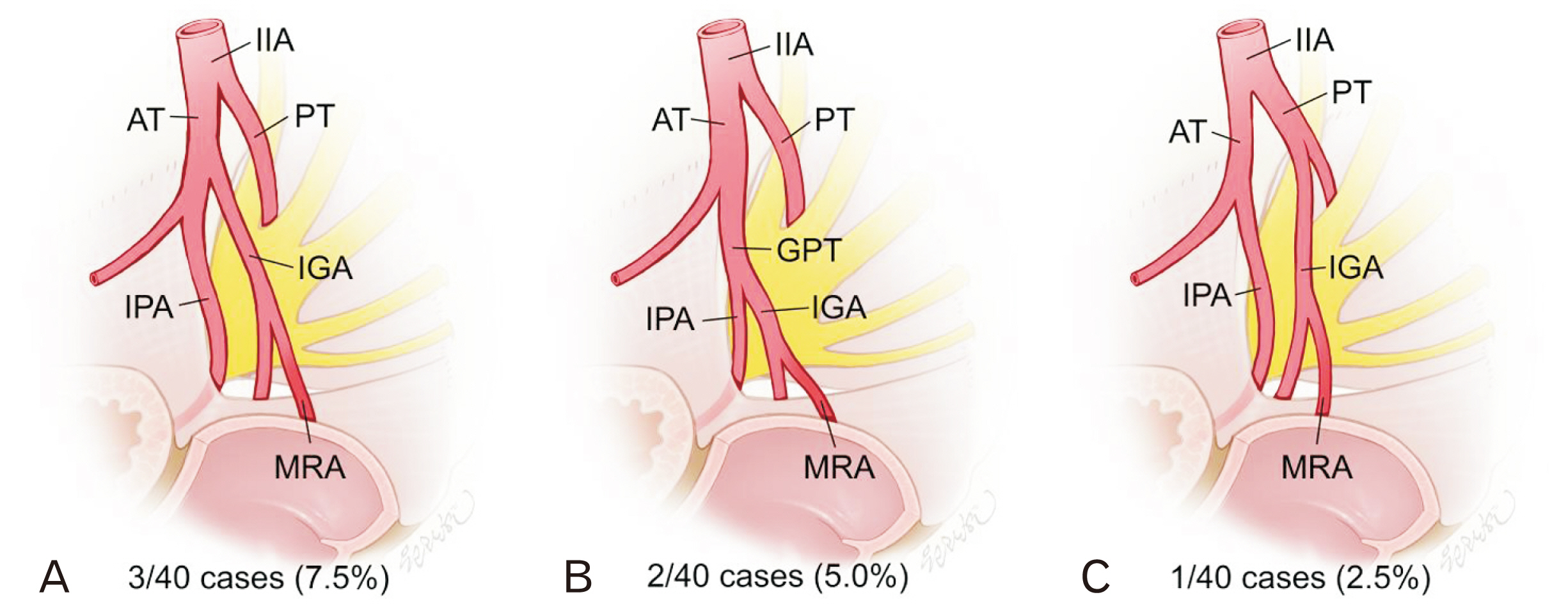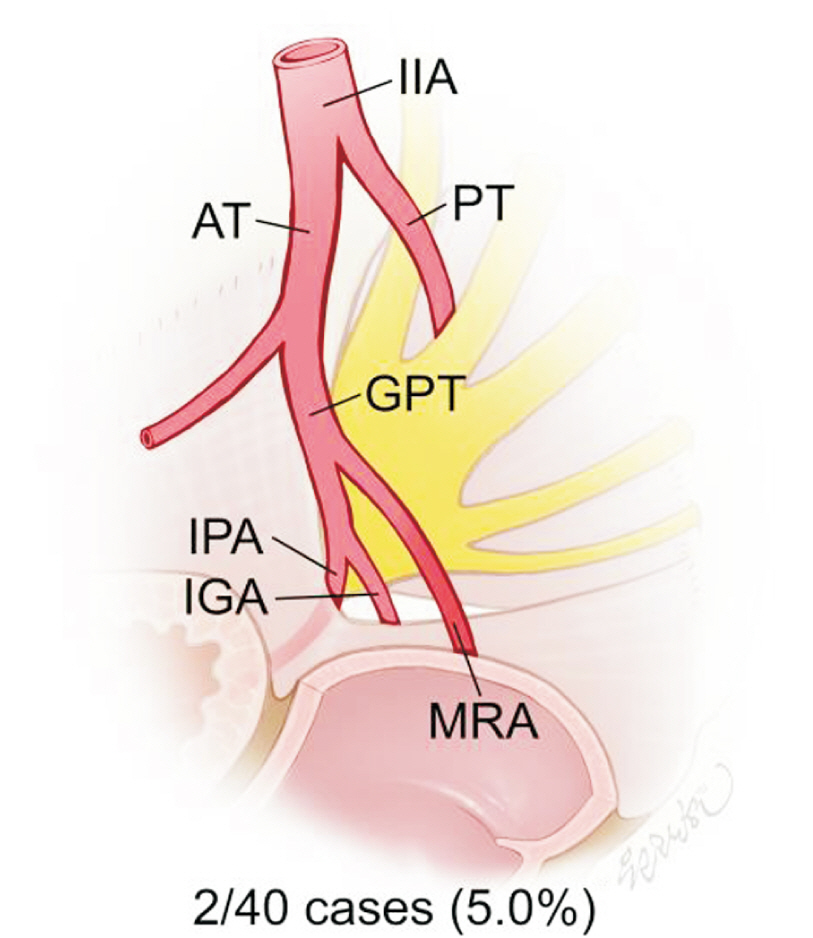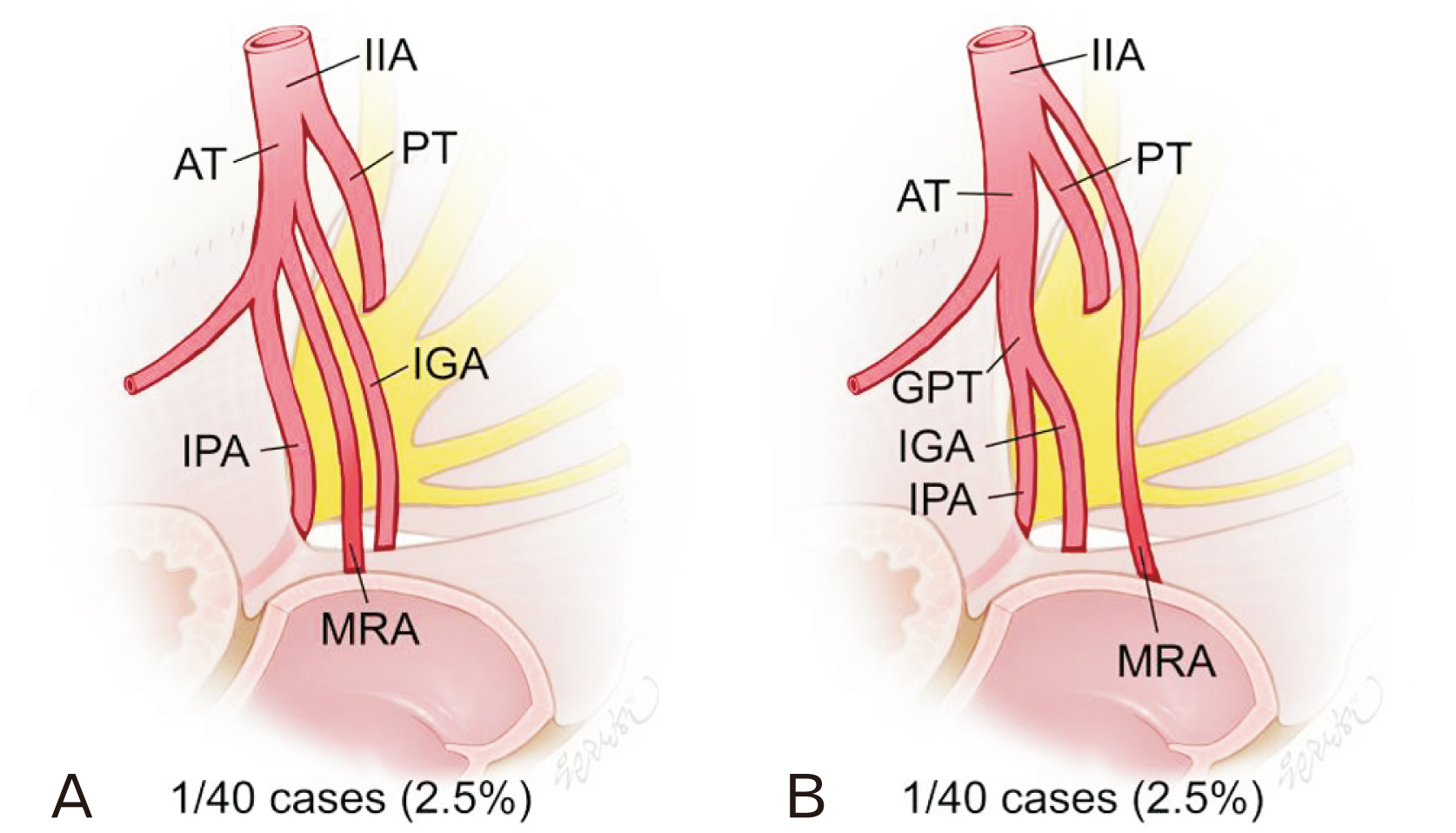Anat Cell Biol.
2022 Jun;55(2):118-123. 10.5115/acb.22.010.
Anatomical classification of middle rectal arteries regarding detailed vasculature patterns
- Affiliations
-
- 1Department of Anatomy, College of Medicine, The Catholic University of Korea, Seoul, Korea
- 2The Catholic Institute for Applied and Clinical Anatomy, College of Medicine, The Catholic University of Korea, Seoul, Korea
- 3Division in Biomedical Art, Incheon Catholic University Graduate School, Incheon, Korea
- KMID: 2531196
- DOI: http://doi.org/10.5115/acb.22.010
Abstract
- This study aimed to clarify the anatomy of middle rectal artery and pelvic vasculature patterns, and to provide schematic information in a manner applicable to the total mesorectal excision. Forty sides of pelvis from 20 formalinembalmed cadavers (10 male, 10 female) were dissected, and all the pelvic vasculatures from the internal iliac artery were investigated, focusing on the middle rectal artery. Middle rectal arteries were classified into major types depending on their vascular origins. Each type was subdivided into minor types according to variability of the pelvic vasculature. A middle rectal artery was identified in 18 out of 20 cadavers, and in 25 out of 40 pelvic sides. In most cases, the middle rectal artery originated from the internal pudendal artery or inferior gluteal artery. These two arteries arose directly from the anterior trunk of the internal iliac artery or were bifurcated from the gluteal-pudendal trunk. In rare cases, these arteries arose from the posterior trunk of the internal iliac artery. The other origins of the middle rectal artery included the gluteal pudendal trunk, inferior vesical artery, internal iliac artery, obturator artery, and the prostatic artery, and the pelvic vasculatures in these cases also presented variability. The detailed anatomical findings related to the middle rectal artery and pelvic vasculatures are noteworthy for their improved clinical applicability.
Keyword
Figure
Reference
-
References
1. Heald RJ, Ryall RD. 1986; Recurrence and survival after total mesorectal excision for rectal cancer. Lancet. 1:1479–82. DOI: 10.1016/S0140-6736(86)91510-2. PMID: 2425199.
Article2. Kapiteijn E, Putter H, van de Velde CJ. 2002; Impact of the introduction and training of total mesorectal excision on recurrence and survival in rectal cancer in The Netherlands. Br J Surg. 89:1142–9. DOI: 10.1046/j.1365-2168.2002.02196.x. PMID: 12190680.
Article3. Knol J, Keller DS. 2020; Total mesorectal excision technique-past, present, and future. Clin Colon Rectal Surg. 33:134–43. DOI: 10.1055/s-0039-3402776. PMID: 32351336. PMCID: PMC7188504.
Article4. Kiyomatsu T, Ishihara S, Murono K, Otani K, Yasuda K, Nishikawa T, Tanaka T, Hata K, Kawai K, Nozawa H, Yamaguchi H, Watanabe T. 2017; Anatomy of the middle rectal artery: a review of the historical literature. Surg Today. 47:14–9. DOI: 10.1007/s00595-016-1359-8. PMID: 27260317.
Article5. DiDio LJ, Diaz-Franco C, Schemainda R, Bezerra AJ. 1986; Morphology of the middle rectal arteries. A study of 30 cadaveric dissections. Surg Radiol Anat. 8:229–36. DOI: 10.1007/BF02425072. PMID: 3107146.6. Sato K, Sato T. 1991; The vascular and neuronal composition of the lateral ligament of the rectum and the rectosacral fascia. Surg Radiol Anat. 13:17–22. DOI: 10.1007/BF01623135. PMID: 2053040.
Article7. Bilhim T, Pereira JA, Tinto HR, Fernandes L, Duarte M, O'Neill JE, Pisco JM. 2013; Middle rectal artery: myth or reality? Retrospective study with CT angiography and digital subtraction angiography. Surg Radiol Anat. 35:517–22. DOI: 10.1007/s00276-012-1068-y. PMID: 23296842.
Article8. Jones OM, Smeulders N, Wiseman O, Miller R. 1999; Lateral ligaments of the rectum: an anatomical study. Br J Surg. 86:487–9. DOI: 10.1046/j.1365-2168.1999.01080.x. PMID: 10215819.
Article9. Ayoub SF. 1978; Arterial supply to the human rectum. Acta Anat (Basel). 100:317–27. DOI: 10.1159/000144913. PMID: 619506.
Article10. Vogel P, Klosterhalfen B. 1988; The surgical anatomy of the rectal and anal blood vessels. Langenbecks Arch Chir. 373:264–9. German. DOI: 10.1007/BF01276542. PMID: 3268710.11. Schuurman JP, Go PM, Bleys RL. 2009; Anatomical branches of the superior rectal artery in the distal rectum. Colorectal Dis. 11:967–71. DOI: 10.1111/j.1463-1318.2008.01729.x. PMID: 19175645.
Article12. Standring S. 2016. Gray's anatomy: the anatomical basis of clinical practice. 41st ed. Elsevier;Amsterdam: DOI: 10.1111/j.1463-1318.2009.02042.x.13. Moore KL, Dalley AF, Agur AMR. 2018. Clinically oriented anatomy. 8th ed. Wolters Kluwer;Philadelphia: DOI: 10.1111/j.1463-1318.2009.02042.x.14. Clegg EJ. 1955; The arterial supply of the human prostate and seminal vesicles. J Anat. 89:209–16. PMID: 14367216. PMCID: PMC1244783.15. Syed MI, Chaudhry N, Shaikh A, Morar K, Mukerjee K, Damallie E. 2007; Catheter-directed middle hemorrhoidal artery embolization for life-threatening rectal bleeding. Can J Gastroenterol. 21:117–23. DOI: 10.1155/2007/272641. PMID: 17299617. PMCID: PMC2657672.
Article
- Full Text Links
- Actions
-
Cited
- CITED
-
- Close
- Share
- Similar articles
-
- Microsurgical Anatomy of the Middle Cerebral Artery
- Prevalence and clinical relevance of the anatomical variations of suprarenal arteries: a review
- The branching patterns and termination points of the facial artery: a cadaveric anatomical study
- Anatomical considerations of the superior thyroid artery: its origins, variations, and position relative to the hyoid bone and thyroid cartilage
- Coronary Angiographic Findings of Left Atrial Thrombi in Mitral Stenosis







